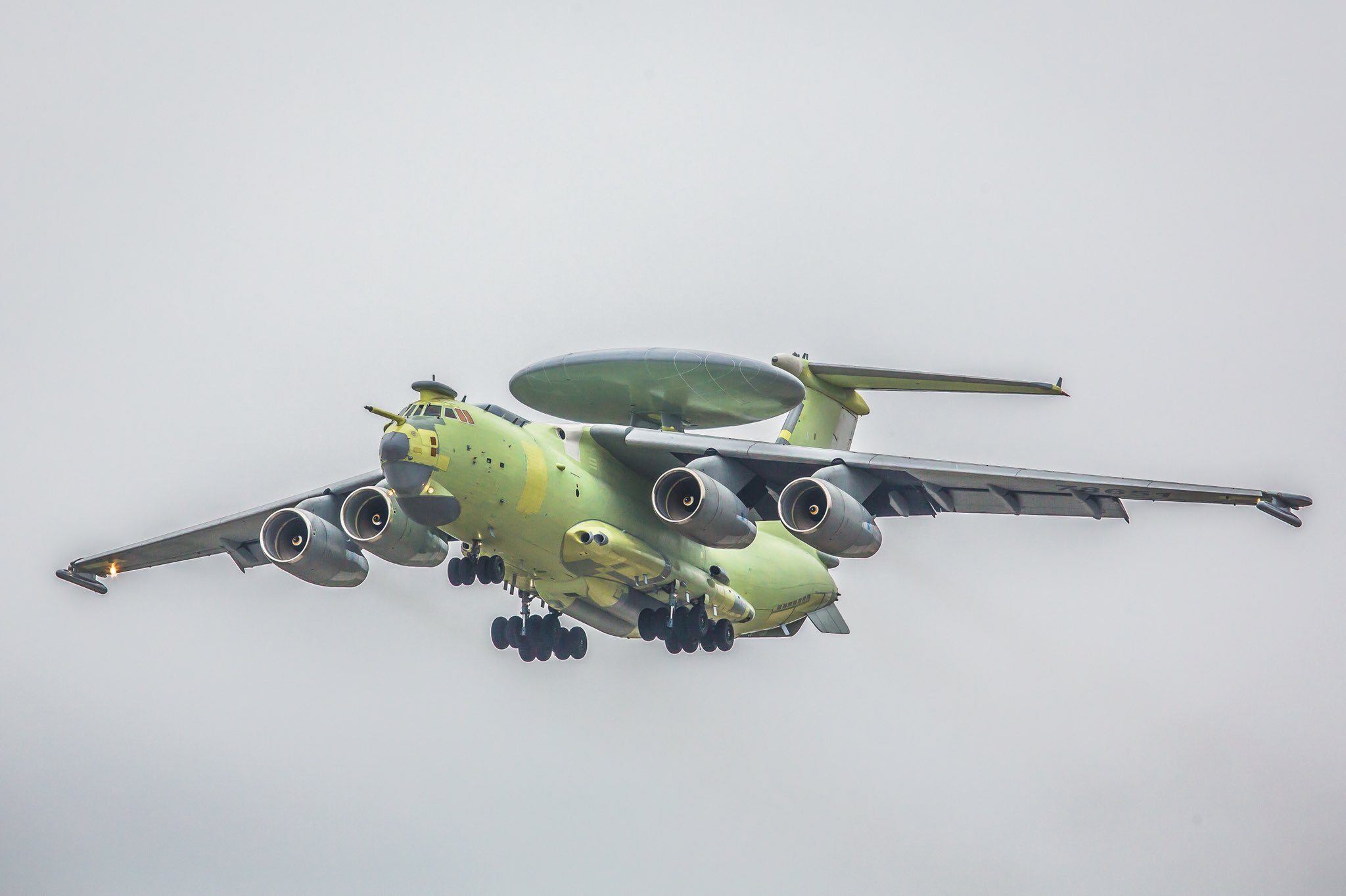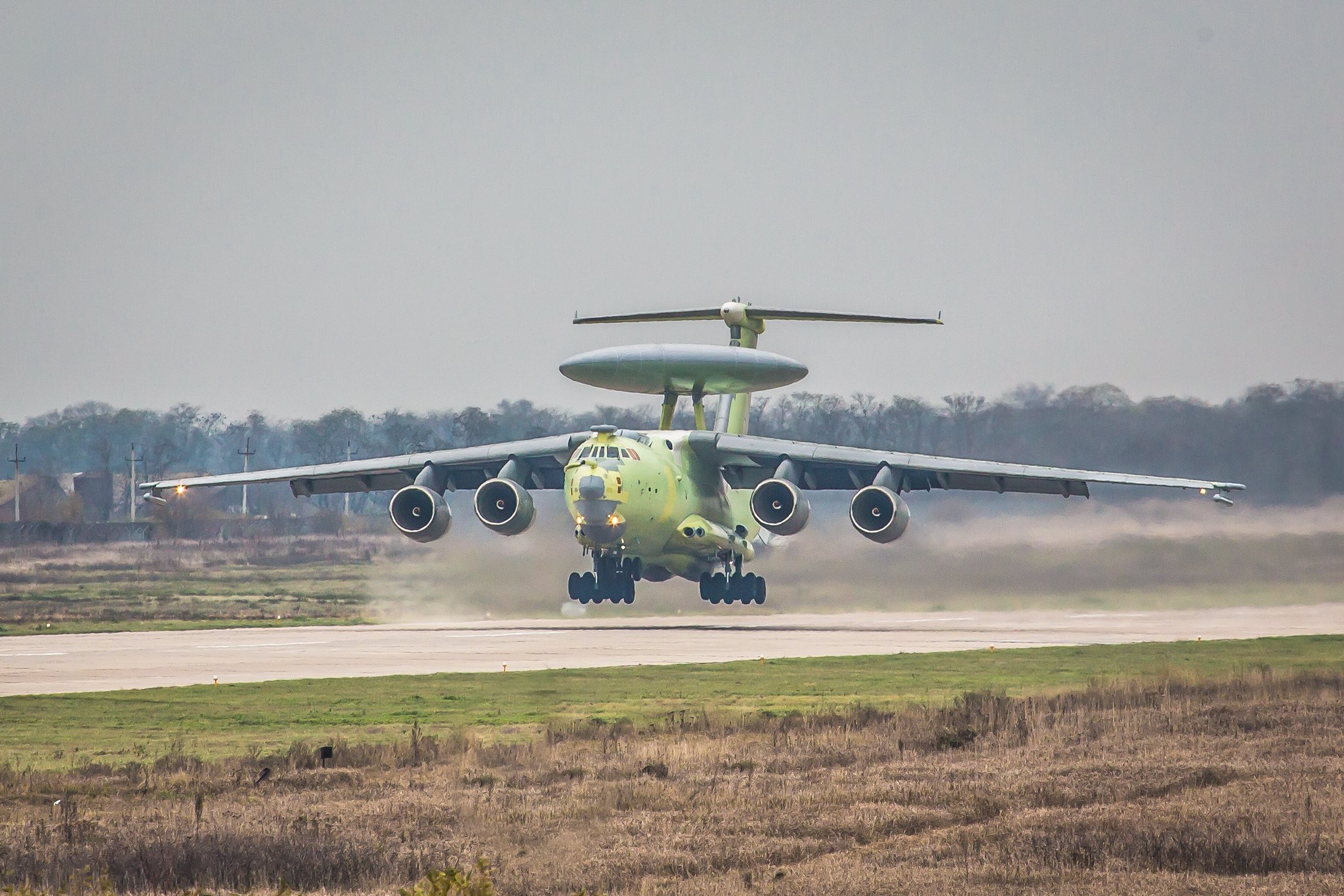Western sanctions imposed on Russia are resulting in delays to the country’s next-generation airborne early warning and control (AEW&C) aircraft, the A-100 Premier, according to reports in an influential Russian military publication. The A-100, which is intended to provide a significant advantage over the 1980s-era A-50 Mainstay now operated by the Russian Aerospace Forces (VKS), is now not expected to be available until 2024, while there are growing concerns that its predecessor is lacking capabilities that would be critical in modern high-end battles. The Premier program was launched in 2006 and the A-100 was previously expected to be fielded by late 2020.
A recent article in the military and defense newspaper Voyenno-Promyshlenny Kuryer outlines the delayed timeline for the A-100, citing an unnamed source within the Russian Ministry of Defense. The reason given for the holdup is the delays in the delivery of electronic components for the aircraft, including microchips, as a result of sanctions, some of which have been imposed on Russia in recent years by the European Union, the United States, and individual nations.

“Electronics, like much aside, have come under Western sanctions, which have hurt the Premier project,” the article states. At the same time, Russian efforts to produce replacements for foreign-made microchips used in the A-100 “have encountered problems.”
The Voyenno-Promyshlenny Kuryer describes what it calls a “strategic mistake” in the early development of the A-100 before sanctions were imposed on Russia in response to its annexation of Crimea from Ukraine in 2014. Further punitive measures were introduced after the poisoning of former spy Sergei Skripal in the United Kingdom in 2018, and allegations of Russian interference in the 2016 U.S. election.
Since the A-100 program originates in the period before these sanctions, economic security factors did not play into the sourcing of at least some of the foreign components. While not specified in the report, it would seem the ultimate responsibility for this decision would lie with the Russian Ministry of Defense.
The Premier is a joint development involving various Russian defense and aerospace contractors. Aviastar-SP provides the Il-76MD-90A transport aircraft, a much-modernized version of the Il-76 Candid, that serves as the platform, and Beriev is responsible for integrating the radar and avionics into the airframe. Meanwhile, military electronics manufacturer Vega produces the Premier mission system.

The report argues that blame for A-100’s delays should not be placed exclusively with Aviastar-SP and Beriev, which have already produced a prototype with a mission system installed and that has been undergoing testing since its first flight in November 2017.
Nevertheless, the trials program has also been subject to delays, the article describing “long and painful efforts to bring [the A-100] to a level corresponding to the tactical and technical requirements.”
Meanwhile, Aviastar-SP is already struggling to meet its contractual obligations to build Il-76MD-90A transports, with the plant so far having completed just eight from the 39 that are scheduled to be built by the end of this decade. The availability of these airframes, which are also in demand for modernization of the VKS transport branch, may well also affect the timeline for the A-100.

There has been some disruption at Vega, too, with the director of the group having been replaced in 2017, which apparently exacerbated the problems with the A-100.
Ultimately, the heavy reliance of the A-100 program on Western electronic components reflects a wider malaise in Russia, which continues to lag behind in this field. Voyenno-Promyshlenny Kuryer states that Russia is at least 10 years behind the West in terms of these kinds of technologies. This, at least partly, is also a hangover from the Cold War, when Western economic measures blocked the sale of high-technology items to the Soviet Union.
It’s unclear what, if any, the repercussions will be for the manufacturers involved in the A-100 program, although the Russian Ministry of Defense is said to be “concerned.” The Premier has already missed deadlines stipulated in previously agreed contracts.
In the meantime, the VKS is relying on its fleet of A-50 AEW&C aircraft, which first entered service in 1984. In an effort to keep the aircraft up to date, the Mainstays are undergoing a mid-life upgrade to A-50U standard, which features a new computing system with digital signal processing that’s said to be much more reliable than the previous analog equipment. Reports suggest the A-50U can track up to 150 targets at a range of over 370 miles, compared with 45 targets at 140 miles for the original A-50. It should be noted that radar range varies considerably depending on operating height, terrain, and target type, with these figures being applicable to the optimum high-altitude flight profile.
A-50U is also said to be better able to detect and track fast-flying targets as well as helicopters, even when facing enemy electronic warfare systems.
An upgraded A-50U conducts an air interception exercise with VKS fighters:

Otherwise, the A-50 also offers an important lookdown capability, meaning it can spot low-flying aircraft and missiles in complex terrain, making it a potentially critical gap-filler in areas not necessarily covered by ground-based radar. In one example of this, back in 2015, an A-50 directed four MiG-31 Foxhound interceptors that successfully knocked down a Kh-55 cruise missile during a test. These capabilities are expected to be further enhanced in the A-100.
Meanwhile, the upgrade of the existing Mainstay fleet continues, with a seventh upgraded A-50U reportedly delivered to the VKS last December.
With only around 10 examples of the A-50 and A-50U in active VKS service, the fleet is also in great demand, including detachments at Khmeimim Air Base in Syria, where the aircraft has been operating since Moscow launched its intervention in the civil war in 2015. The aircraft are also regularly used to support long-range ‘patrol’ missions by both strategic bombers and interceptors.
An A-50 returns to its home base in Ivanovo after a deployment to Syria:

However, even after the upgrade, the A-50U still relies on older-generation technology, including a mechanically scanned radar array. Above all, the radar is said to struggle to identify and track stealthy aerial targets.
While the A-100 retains the same basic configuration as the A-50, its S-band radar uses active electronic scanning in elevation, with mechanical scanning in azimuth. Various other antennas located around the airframe suggest the aircraft also has extensive electronic support measures capabilities, a topic we have discussed in depth before.
While the A-50 soldiers on, the need for the A-100 becomes more acute while earlier claims by Russian Minister of Defense Sergei Shoigu that around 30 of the new radar planes would be in service by the end of the 2020s look even more fanciful. The Premier would not be the first Russian high-tech military program to run into such problems, which have also been exacerbated by limited defense budgets.
The A-100’s issues also raise the question of the degree to which Western sanctions are also affecting other Russian programs. With advanced electronic components being a particular Achilles’ heel, it’s likely that similar problems are being faced elsewhere in the military-industrial complex. While we don’t know which particular sanctions are affecting the A-100, this new report, although anonymously sources, is in keeping with other reports on this topic including, for example, the difficulty in obtaining silver-zinc batteries for the fire-damaged Russian Navy submarine Losharik.
In the past, Viktor Kladov, a senior official at Rostec, the Russian state-owned conglomerate specializing in defense and high-tech industries, said that the group was seeking to acquire full independence in terms of its supply chains, removing the reliance on foreign firms in the wake of sanctions imposed in the wake of the Crimea crisis. While Kladov was referring specifically to civil aerospace products, the same ambition would likely apply to military aircraft — Rostec is responsible for Aviastar-SP and Beriev (under the United Aircraft Corporation) and Vega.
It is notable that the latest version of the Flanker multirole fighter for Russian use, the Su-30SM2, reportedly features all-Russian electronic components, these replacing the French-made systems found in the previous Su-30SM. French-supplied items had included the head-up display (HUD), the inertial/GPS navigation system, plus multifunctional cockpit displays. The first examples of the Su-30SM2 began to be delivered to the Russian Navy last month.
Further sanctions are expected if Moscow launches a new intervention in Ukraine, including potentially blocking Russia’s access to global electronics supplies. With that prospect in mind, the situation for the A-100 Premier, and for other programs, has the potential to deteriorate further.
Contact the author: thomas@thedrive.com
